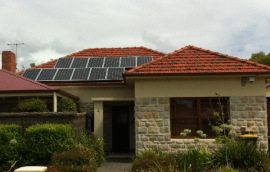One thing I find very odd about the world is that even today when solar panels are being installed from Canada to Tasmania and powering everything from laptops to fish tank filters to cars, there are still people who appear to wake up in the morning and decide that their mission for the day is to tell the internet that solar is too diffuse a source of energy to be practical. And while I have to admire the persistence of some of these people, I really can’t say I’m a big fan of their logic, their habit of rejecting evidence they don’t like, or their general lack of comprehension of the reality of how solar power is currently used in the world.
I will take it as read that the world’s most widely used source of electricity, coal power, is not too diffuse to be practical. If it was, we obviously wouldn’t be in the unfortunate position of using so much of it. So I will compare solar with coal and consider different ways of looking at how concentrated they are as sources of electricity.
However, I doubt many people will think this is the right way to go about comparing them. I certainly don’t think that the people who say solar power is too diffuse to be practical will care that coal power often comes from a vast distance away while solar power is right here. So instead I will look at electricity produced per square meter of land dedicated to its production.

Recently I wrote about how the Hazelwood coal power plant and its mine produced an average of about 32 watts per square meter, which is much lower than wind farms. Hazelwood is located in a very cloudy location for Australia, but if I covered its entire 3,554 hectares with commercially available, 20% efficient, Sunpower solar panels, it would produce kilowatt-hours equal to about 85% of Hazelwood’s current average output. If these solar panels were instead installed in a better location in the same state they would exceed Hazelwood’s average output and in a great deal of Australia they would almost double it.
Clearly solar power can’t be considered too diffuse if it is possible for its average output per square meter to exceed that of coal power plants. But this isn’t actually the right way to go about comparing coal and solar. This is because in Australia we almost never put solar panels on the ground. Apart from 10 megawatts in Western Australia and a few installations done by people who are afraid of heights, almost all of Australia’s approximately 2.2 gigawatts of solar capacity is mounted on roofs and doesn’t remove any land from its original use. This means that Australian solar power produces more than 50 times as much electricity per square meter of dedicated land than coal power.
While Australians are very disinclined to put solar panels on the ground, this is less true in places such as Europe and India but this still does not make solar power too diffuse to be practical. In the case of India, almost all of their solar capacity consists of low efficiency, thin-film solar panels mounted on the ground which produce much less electricity per square meter than any coal plant operating at its originally intended capacity. But despite this, India is now building solar farms that will produce electricity at a cost of about 12 cents a kilowatt-hour which is competitive with electricity from new coal plants. So while Indian solar takes up more land than coal per kilowatt-hour produced, it’s obviously not too diffuse to compete with it even when coal power is not paying anything close to the full cost of the harm it causes.
While looking at the area of land required is one way to consider how diffuse a source of electricity is, another is to study the average number of kilowatt-hours produced per kilogram of mass required. A rooftop solar system with 15% efficient panels that receives a not-particularly impressive average of 4.5 hours of sunlight a day will produce about 400 kilowatt-hours per kilogram of its total system weight over its lifetime. Whereas coal power, due to the massive amount of coal it burns, will only produce about 2 kilowatt-hours per kilogram of mass required. This makes electricity from rooftop solar approximately 200 times more concentrated a source of electricity than coal power. If the mass of the oxygen required to combust the coal is included then rooftop solar is about 400 times more concentrated.
So despite what you may occasionally see scrawled on the internet, in Australia and many other regions, solar power is a much more concentrated source of electricity than coal in terms of the amount of land it requires. And in India where solar power is more diffuse than coal in terms of land used, it is still competitive with new coal even when coal doesn’t pay anywhere near the full cost of its externalities. And in terms of kilowatt-hours produced per kilogram of mass required, solar power is a far more concentrated source of electricity than coal anywhere in the world and the only thing that can change that is if you make me include the mass of the sun in my calculations.










